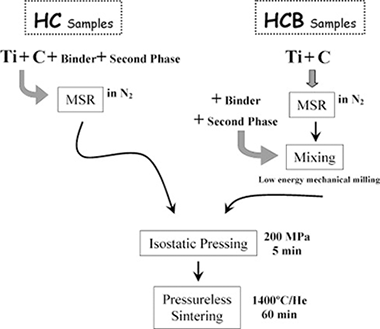Artículos SCI
2009
2009
Materiales Nanoestructurados y Microestructura - Reactividad de Sólidos
Properties of Ti(C,N) cermets synthesized by mechanically induced self-sustaining reaction
Cordoba, JM; Sanchez-Lopez, JC; Aviles, MA; Alcala, MD; Gotor, FJJournal of the European Ceramic Society, 29 (2012) 1173-1182
Show abstract ▽

The properties of TiCxN1−x/(Ni or Co) cermets sintered by a pressureless method from powder mixtures, and obtained for the first time by a mechanically induced self-sustaining reaction process (MSR), were studied. The hardness, toughness, friction and wear coefficients, and oxidation resistance were determined. It was shown that cermets obtained from powdered materials synthesized in one single MSR step possessed improved mechanical properties, similar to those obtained in cermets with more complex bulk compositions. Higher wear resistances were observed in cermets whose hard phase was richer in carbon. The oxidation resistance of the cermets depended primarily on the binder composition. This resistance was better for those cermets with cobalt as the binder. Superior oxidation resistance was displayed when small amounts of W or Mo were incorporated into the binder.
Abril, 2009 | DOI: 10.1016/j.jeurceramsoc.2008.08.019
Materiales Avanzados
Effect of the grinding mechanical treatment on the pyrophilite textural properties
Sanchez-Soto, PJBoletín de la Sociedad Española de Cerámica y Vidrio, 48 (2009) 59-68
Show abstract ▽
Nanotecnología en Superficies y Plasma
Wetting Angles on Illuminated Ta2O5 Thin Films with Controlled Nanostructure
Rico, V; Borras, A; Yubero, F; Espinos, JP; Frutos, F; Gonzalez-Elipe, ARJournal of Physical Chemistry C, 113 (2009) 3775-3784
Show abstract ▽

Ta2O5 thin films with different nanostructure and surface roughness have been prepared by electron evaporation at different angles between the evaporation source and the substrates. Large variation of refraction indexes (n) from 1.40 to 1.80 were obtained by changing the geometry of evaporation and/or by annealing the evaporated films at increasing temperatures up to 1000 °C to make them crystalline. Very flat and compact thin films (n = 2.02) were also obtained by assisting the growth by bombardment with O2+ ions of 800 eV kinetic energy. A similar correlation has been found between the wetting contact angle of water and the roughness of the films for the evaporated and evaporated + annealed samples, irrespective of their procedure of preparation and other microstructural characteristics. When the films were illuminated with UV light of h > Eg = 4.2 eV (Eg, band gap energy of Ta2O5), their surface became superhydrophilic (contact angle < 10°) in a way quite similar to those reported for illuminated TiO2 thin films. The rate of transformation into the superhydrophilic state was smaller for the crystalline than for the amorphous films, suggesting that in Ta2O5 the size of crystal domains at the surface is an important parameter for the control of this kinetics. Changes in the water contact angle on films illuminated with visible light were also found when they were subjected to implantation with N2+ ions of 800 eV kinetic energy. The origin of this photoactivity is discussed in terms of the electronic band gap states associated with the nitrogen-implanted atoms. The possibility of preparing antireflective and self-cleaning coatings of Ta2O5 is discussed.
Marzo, 2009 | DOI: 10.1021/jp805708w
Materiales Nanoestructurados y Microestructura
Duplex SiCN/DLC coating as a solution to improve fretting—Corrosion resistance of steel
Pech, D; Schupp, N; Steyer, P; Hack, T; Gachon, Y; Heau, C; Loir, AS; Sanchez-Lopez, JCWear, 266 (2009) 832-838
Show abstract ▽

Fretting corrosion damages are commonly observed when two metallic bodies, which are in contact with each other, are subjected to oscillatory motions of low amplitude. Such kind of degradation mode is often responsible for limited durability of aeronautical joints. In the present paper, a multifunctional duplex coating based on Si–C–N and diamond-like carbon (DLC) materials, combining corrosion resistance and good tribological properties is described. Amorphous hydrogenated SiC, SiCN, SiC/DLC and SiCN/DLC were deposited on steel substrates by a plasma assisted chemical vapour deposition (PACVD) technique, using tetramethylsilane (TMS), ammonia (NH3) or acetylene (C2H2) as gas precursors. Nitrogen incorporation has shown to improve the corrosion protection ability of SiC coatings. The corrosion behaviour and the tribological performance in aqueous media of SiCN/DLC coating have therefore been investigated. A test rig has been designed to validate the fretting resistance of this duplex coating for aeronautic applications. It was found that the combination of a SiCN-based PACVD sublayer with a DLC topcoat could provide an enhanced solution to withstand both fretting and corrosion.
Marzo, 2009 | DOI: 10.1016/j.wear.2008.12.007
Nanotecnología en Superficies y Plasma
Growth Mechanism and Chemical Structure of Amorphous Hydrogenated Silicon Carbide (a-SiC:H) Films Formed by Remote Hydrogen Microwave Plasma CVD From a Triethylsilane Precursor: Part 1
Wrobel, AM; Walkiewicz-Pietrzykowska, A; Ahola, M; Vayrynen, IJ; Ferrer-Fernandez, FJ; Gonzalez-Elipe, ARChemical Vapor Deposition, 15 (2009) 39-46
Show abstract ▽
Amorphous hydrogenated silicon carbide (a-SiC:H) films are produced by remote microwave hydrogen plasma (RHP)CVD using triethylsilane (TrES) as the single-source precursor. The reactivity of particular bonds of the precursor in the activation step is examined using tetraethylsilane as a model compound for the RHP-CVD experiments. The susceptibility of a TrES precursor towards film formation is characterized by determining the yield of RHP-CVD and comparing it with that of the trimethylsilane precursor. The effect of substrate temperature (Ts) on the rate of the RHP-CVD process, chemical composition, and chemical structure of the resulting a-SiC:H films is reported. The substrate temperature dependence of the film growth rate implies that film growth is independent of the temperature and RHP-CVD is a mass transport-limited process. The examination of the a-SiC:H films, performed by means of X-ray photoelectron spectroscopy (XPS), elastic recoil detection analysis (ERDA), and Fourier transform infrared absorption spectroscopy (FTIR), reveals that the increase in the substrate temperature from 30 °C to 400 °C causes the elimination of organic moieties from the film and the formation of a Si-carbidic network structure. On the basis of the results of the structural study, the chemistry involved in film formation is proposed.
Marzo, 2009 | DOI: 10.1002/cvde.200806726
- ‹ anterior
- 402 of 422
- siguiente ›














